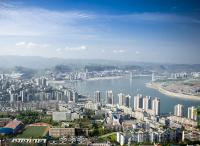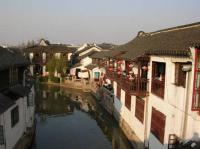Ports of Call
Chongqing Chongqing is located within southeast China's Sichuan Province but since 1997 it has been an independent metropolis under the direct jurisdiction of the Central Government. Squeezed along the confluence of the Yangtze River and Jailing River, this famous "Mountain City" or "Foggy City" is home to some 6 million people, while approximately 30 million people live in the counties and districts surrounding the old city.
Chongqing is located within southeast China's Sichuan Province but since 1997 it has been an independent metropolis under the direct jurisdiction of the Central Government. Squeezed along the confluence of the Yangtze River and Jailing River, this famous "Mountain City" or "Foggy City" is home to some 6 million people, while approximately 30 million people live in the counties and districts surrounding the old city.
Called Yu for short, Chongqing was established some 3000 years ago at the time of the Ba Kingdom. As an inland port it was opened to foreign trade in 1890 and played a key role in the economy of the southwest region. During World War II, it was the provisional capital of China (1938-1945). The Japanese bombed the city heavily and only the long foggy winters saved the city from worse damage. Chongqing or "Chungking" was known to most of the world as heavily bombarded yet brave city.
Today Chongqing is an important industrial city and a popular tourist destination. The renowned Three Gorges - one of the natural wonders of the world - are just 20 hours sailing away, so Chongqing is the start or end point for most Yangtze River cruises. The streets are staggered one above the other on the hills that overlook the river, making the city a magnificent sight to behold. The night scene of the city is very charming. Another unique aspect is the absence of bicycles, there's barely a cyclist to be found, as the hill climbs make it coronary country for any would-be rider.
Attractions:
Dazu Grottos
163km northwest of Chongqing, it has been listed in World Cultural Heritage in 1999 by UNESCO. The main groupings are at North Hill (Beishan) and Baoding Hill, which date from the Tang Dynasty (9 th century) to the Song (13 th century).
Arhat Temple (Luohan Temple)
Built about 1000 years ago, the temple has a long entranceway flanked by rock carvings, a hall of painted terracotta arhat sculptures and a hall containing a large gold Buddha figure. Behind the Buddha altar is an Indian-style mural depicting Prince Siddhartha in the process of his secular life to ultimate nirvana.
Chongqing Zoo
first opened in 1954, it is a lovely place to see giant pandas.
 Yichang
Yichang
Known as Yilling in ancient times, Yichang is located at the east mouth of Xiling Gorge, the west ends of Three Gorge - a strategically important passage between Sichuan and Hubei provinces. It serves as a major transit port along the middle reaches of Yangtze River.
Situated as it is on the intersection of the upper and middle reaches of the Yangtze River , Yichang has a number of scenic and historical sites. Local produce is seedless orange, much exported to Japan and Southeast Asia. Terra cotta wares, mushroom, black tea, garden plants and decorations, are among those renowned local specialties.
The shiplock in Gezhouba Dam is the border between the Three Gorges and the middle reaches of Yangtze River . The world famous Three Gorges Dam is just 30 km away from the city. Along with the progress of the Three Gorges Project, Yichang will increase in importance as an industrial city and as a tourist center. In the city, the Three Gorges Dam model and the Chinese Sturgeon Aquarium & Research Institute are the haunts of the tourists. Three Travelers Cave overlooks the Nanjin Pass of the Yangtze magnificent scenery of the Xiling Gorge.
Attractions:
Chinese Sturgeon Aquarium
Located in Shuixita Town , Yichang City , the Chinese Sturgeon Aquarium is part of the Chinese Sturgeon Institution of China. The Chinese Sturgeon is an animal strictly protected by Chinese government. It has a history of 140 million years, almost the same as dinosaur. That is why it is called "living fossil". A grownup sturgeon measures up to 4 meters long, weighs over 1000 pound, ranking the biggest of all the 27 sturgeons in the world and biggest animal in the Yangtze River.
 Wuhan :
Wuhan :
Wuhan was the only city on the Yangtze River that can truly be said to lie on both sides of the river. It is one of the most populous cities in China with a population of more than 7.3 million. Its strategic location makes it a major junction of transportation and communications in central China, the city has long been referred as "the Thoroughfare to Nine Provinces".
The city has a history of 3500 years and once was the center of "Chu" culture, left behind itself a lot of historical and cultural relics. Numerous natural and historical attractions are scattered around. Yellow Crane Tower, Guiyuan Temple , East Lake, Yangtze River Bridge, Hubei Provincial Museum, and Ancient Music Pavilion among those where the visitors want to go.
Attractions:
Yellow Crane Tower :
Yellow Crane Tower , located on Snake Hill in Wuchang, is one of the "Three Famous Towers South of Yangtze River (the other two: Yueyang Tower in Hunan and Tengwang Tower in Jiangxi ). The existing tower was rebuilt in 1981 and opened to the public in June 1985. It is a symbol of the Wuhan City .
According to records, the tower was first built in 223 A .D during the Three Kingdoms period (220-280). Destroyed many times in successive dynasties, the tower was rebuilt time and again.
East Lake & Hubei Provincial Museum :
It is the city's most popular tourist site, with 2 million visitors each year. Located in the eastern suburbs of Wuhan , the East Lake is the biggest lake in a city within China and one of the major tourist attractions in Wuhan . With surrounding park, it occupies an area of 88 sq. km including water area of 33 km. The scenery around the lake is lovely, including flowers and willow trees as well as pavilions and terraces. A ride in one of the tour boats is a tranquil experience.
The Hubei Provincial Museum established in 1953 contains the most important collections of artifacts in the province. More than 140,000 items, mainly from a big tomb excavated in 1978, are well preserved here, including 645 first class cultural relics and 16 national treasures.
 Shanghai:
Shanghai:
Shanghai China, a municipality directly under the Central Government, is one of the largest commercial city and economic center of China. It's a coastal opening city as well as a famous historic and cultural one. Situated 31.4 degrees north latitude and 121.29 degrees east longitude, Shanghai lies in the middle of China's mainland coastline, and Yangtze River 's entrance to the sea. Covering an area of 6,341 square km. and with a population of more than 13.5 million, it is the largest city in China and one of the five super cities of the world. Shanghai is also one of ten world's largest seaports.
The Pudong Development Area in Shanghai is a newly-booming economic zone in China . The level of the new area's industry, commerce, finance, trade, post and telecommunications stands at the forefront in China. More than 130 buildings there are higher than a hundred meters.
Attractions:
Yu Garden
Yu Garden is located at the heart of Old Town, a few blocks southwest of the Bund in downtown Shanghai. It is one of China's loveliest private classical gardens. Its name means Garden of Contentment, and it is indeed a pastoral world apart from modern and hectic Shanghai. Its construction was first completed in 1577. Occupying just 2 hectares (5 acres), it nevertheless seems as expansive as a small town, with room for 30 pavilions.
The Bund
The Bund (which means the Embankment) refers to Shanghai's famous waterfront running along the west shore of the Huangpu River, forming the eastern boundary of old downtown Shanghai . Today it consists of a marvelous promenade, stretching from Suzhou Creek in the north to Jinling Lu in the south, the perfect platform for strolling along the busy river. Just across the wide avenue (Zhongshan Dong Yi Lu) that parallels the promenade is Shanghai's signature cityscape, a long wall of colonial-era European buildings erected by foreign governments, trading houses, and expatriate millionaires mostly during the prosperous and notorious 1920s and 1930s. On the other side of the river, casting the shadow of Shanghai's future over its colonial past, are the modern towers of the city's remarkable economic boom: the skyscrapers of the Pudong New Area that include some of Asia's and the world's tallest structures, the high-tech pagodas of the 21st century.
Shanghai Museum
Newly relocated from west Shanghai, this modern museum tells the story of Shanghai, with special attention to the colonial period from 1860 to 1949, when Shanghai was under European dominance. Over 1,000 relics, mostly from the past 200 years, are housed here. Exhibits include a vehicle collection with trolley cars (the city line opened in 1908), 1920s sedans, a U.S. Jeep (popular after World War II), and cars manufactured recently by VW and Buick in Shanghai; dioramas of the Huangpu River, Bund, and foreign concessions, evoking the street life of the 19th and early 20th centuries; and dozens of models of Shanghai's classic avenues and famous buildings. The museum tour takes about an hour; it ends at an unremarkable gift shop.
Jade Buddha Temple
Shanghai's most popular temple with visitors, the Jade Buddha complex has an exceedingly short history, having been completed in 1918, but it exudes a powerful potion of thick incense, flashy decorations, and a dark, seedy atmosphere that makes it seem centuries older. The White Jade Buddha, located up a narrow set of old stairs on the second floor of Wentang Hall, is the true treasure. Carved in Burma and brought to Shanghai in 1881 by Huigeng, a Chinese pilgrim, it is twice life-size (weighing 205kg / 455 lb. and measuring 2m / 6 ft . 7 in . tall in seated position). In another special pavilion there is a Sleeping Buddha, also carved from a single slab of Burmese jade and brought to Shanghai by the same benefactor.